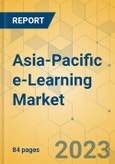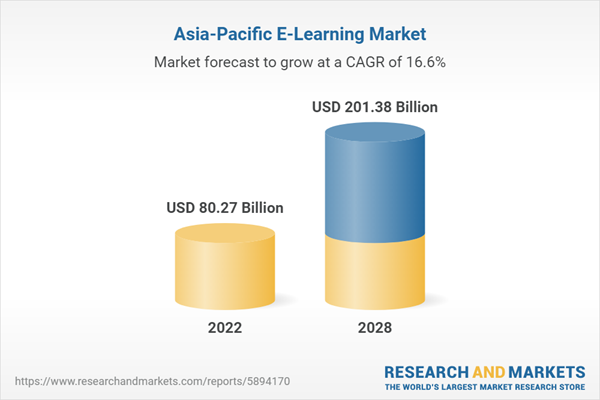Speak directly to the analyst to clarify any post sales queries you may have.
KEY HIGHLIGHTS
- Rapid urbanization and a considerable surge in the use of smartphones to access learning materials are likely to impact the APAC e-learning market. Furthermore, the e-learning market is likely driven by the availability of low-cost smartphones, the rise in disposable income, and the middle-class population's purchasing power, majorly in China, South Korea, and India.
- Consumer buying habits in this region are also heavily impacted by modern technological advances and the emergence of e-commerce. Due to the availability of multiple suppliers offering free or comparatively inexpensive plans to compete with worldwide E-learning platforms in the market, the APAC e-learning market delivers low- and moderately priced course modules.
- Countries such as Japan, South Korea, and Australia have experienced a considerable surge in adopting E-learning platforms over conventional learning methods. The challenge of the market lies in attracting clients for paid content and premium subscriptions from India, Vietnam, Indonesia, and the Philippines, where the need for paid and premium learning content is expected to grow.
- The APAC e-learning market is reportedly in the early growth stage as various factors support its growth. Progressive government policies and the surge in indigenous consumption due to demographic trends have driven infrastructure development in the region. This is crucial in drawing Foreign Direct Investment (FDI) and migration and interaction with the developed world to this region.
- The APAC region will see incremental growth during the forecast period. This is due to increased funding from top investors from China, and growing technological infrastructure with favorable government policies is expected to drive the market during the forecasted period. Hence, this is expected to drive the e-learning market in various APAC countries.
LIST OF VENDORS
Key Vendors
- Oracle
- Adobe
- British Council
- Aptara
- Pearson
- Skillsoft
- Anthology
- NIIT
- Cisco
- BYJU’S
Other Prominent Vendors
- GP Strategies
- McGraw Hill
- D2L
- Cengage Learning
- Coursera
- Learnetic
- IXL Learning
- Udemy
- Unacademy
- eLearn Australia
- Khan Academy
- Indira Gandhi National Open University (IGNOU)
- Chegg
- upGrad
SEGMENTATION & FORECAST
- Delivery Mode (Revenue)
- Packaged Content
- Learning Management System (LMS)
- Others
- Learning Mode (Revenue)
- Self-paced
- Instructor-led
- Function (Revenue)
- Training
- Testing
- End-User (Revenue)
- Corporate
- Higher Education
- K-12
- Government
- Vocational
MARKET STRUCTURE
- Market Dynamics
- Competitive Landscape of APAC E-Learning Market
- Key Vendors
- Other Prominent Vendors
APPENDIX
- Research Methodology
- Abbreviations
- About the Analyst
Table of Contents
Companies Mentioned
- Oracle
- Adobe
- British Council
- Aptara
- Pearson
- Skillsoft
- Anthology
- NIIT
- Cisco
- BYJU’S
- GP Strategies
- McGraw Hill
- D2L
- Cengage Learning
- Coursera
- Learnetic
- IXL Learning
- Udemy
- Unacademy
- eLearn Australia
- Khan Academy
- Indira Gandhi National Open University (IGNOU)
- Chegg
- upGrad
Methodology
Our research comprises a mix of primary and secondary research. The secondary research sources that are typically referred to include, but are not limited to, company websites, annual reports, financial reports, company pipeline charts, broker reports, investor presentations and SEC filings, journals and conferences, internal proprietary databases, news articles, press releases, and webcasts specific to the companies operating in any given market.
Primary research involves email interactions with the industry participants across major geographies. The participants who typically take part in such a process include, but are not limited to, CEOs, VPs, business development managers, market intelligence managers, and national sales managers. We primarily rely on internal research work and internal databases that we have populated over the years. We cross-verify our secondary research findings with the primary respondents participating in the study.

LOADING...
Table Information
| Report Attribute | Details |
|---|---|
| No. of Pages | 84 |
| Published | October 2023 |
| Forecast Period | 2022 - 2028 |
| Estimated Market Value ( USD | $ 80.27 Billion |
| Forecasted Market Value ( USD | $ 201.38 Billion |
| Compound Annual Growth Rate | 16.5% |
| Regions Covered | Asia Pacific |
| No. of Companies Mentioned | 25 |









